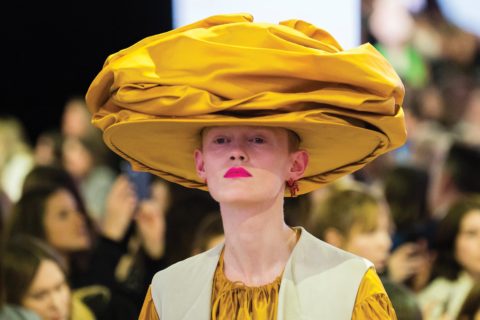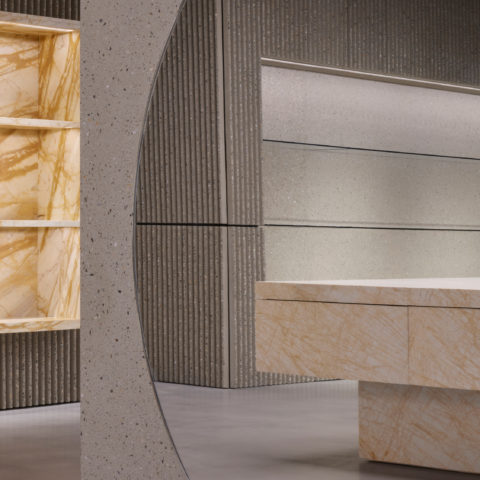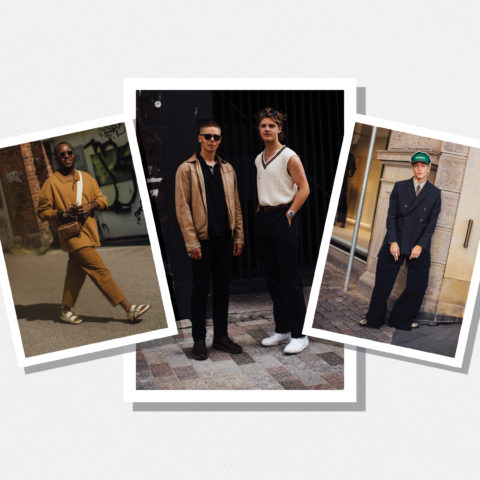Meet the Man Redefining the Classic Mulberry Look
“I think it’s interesting—because I’m not from here and I look at things in a different way. What’s evident for a British person is not the same as for someone outside.”
It’s a 10°C February day in London, and Johnny Coca is freezing. So much so that the bearded, silver-hoop-wearing Spaniard is kitted out in a Mackage puffer jacket when I meet him at Spencer House, the site for his Spring 2018 see-now-buy-now show the following day.
A quick tour of the 18th-century townhouse built for the first Earl Spencer (an ancestor of Diana, Princess of Wales) puts one in mind of British aristocracy, formal tea parties and elaborate china and crystal place settings at dinner, which seems apt for a brand steeped in ye olde British charm. But when I return the next day for the show, I’m guided right through the mansion and out the back doors, past a pink wall dressed in roses, hydrangeas and tulips and into a stark circular space awash in millennial pink and covered in mirrors, reflections of the showgoers bouncing off them every which way.
This paradox between old-world sophistication and youthful eccentricity is an accurate description of Mulberry’s new outlook with Coca at the helm. With stints at Céline, Bally and Louis Vuitton behind him, the designer—who took over at Mulberry in 2015—brings an intuitive understanding of form, structure and construction to the house, as well as a playful and iconoclastic perspective.
“When I arrived at the company, I began thinking about the best way to drive and change the direction of Mulberry,” says Coca. “Culturally speaking, [the Brits] are really proper. There’s a classicism to the culture, with the Queen, the tailoring, the tea time.… But at the same time, it’s very funny because you also have the opposite. They’re breaking all the rules. They can be more eccentric, they can be more rock, they can be punkish, they can play with colours…with tattoos. So my idea was to take these two different directions and try to merge everything.”
It’s easier to subvert tropes when you’re looking at them from the outside, claims Coca, and considering his background (born in Seville, educated in Paris), he is primed to bring an outsider’s decidedly non-British sensibility to the brand. “I think it’s interesting—because I’m not from here and I look at things in a different way,” he muses. “What’s evident for a British person is not the same as for someone outside. I love all the tartan, the check, the Victorian, the history. So perhaps I’m more extreme in the references than someone for whom they’re normal. It gives me more room to twist and to play and have fun.”
A strong element of fun certainly resonates throughout this collection. Imagine a kooky, off-kilter garden party with attendees in organza Edwardian dresses, oversized suits, flouncy blouses and ruffled skirts—all in hues ranging from muted pastels to earthy neutrals to blinding brights.
“Johnny has pushed us toward fabulous colours and more structured designs,” Nick Towe, Mulberry’s head of group quality, told his audience later at one of the workshops organized by the brand over the course of the weekend at London Fashion Week. The house has begun using more chrome-tanned leather, rather than vegetable-tanned leather, says Towe, “because it’s fantastic for colour; it holds its colour. And what does Johnny love? Colours.”
He “really threw some curveballs,” joked Towe, but curveballs are what you need when you’re trying to reinvent a classic house like Mulberry. And Coca threw another when he enlisted Lotta Volkova, the avant-garde 34-year-old Russian known for her work with Vetements and Balenciaga, to style Mulberry’s shows.
“I think you have to be really extreme in your choices if you want to radically change the direction of a brand,” says Coca. “But at the same time, I think it’s really important to keep the heritage as a reference in terms of craft, in terms of spirit. You can’t be extremely different if you don’t have a strong DNA—your base, where you come from, where you are.”
It’s a tightrope, but Johnny Coca’s walking it just fine.








